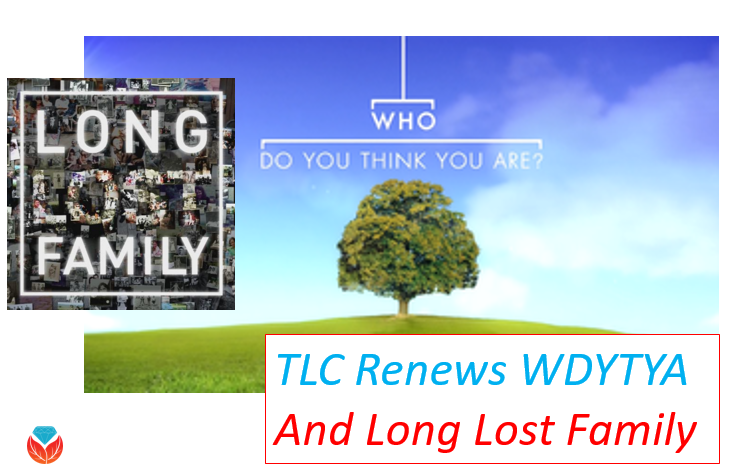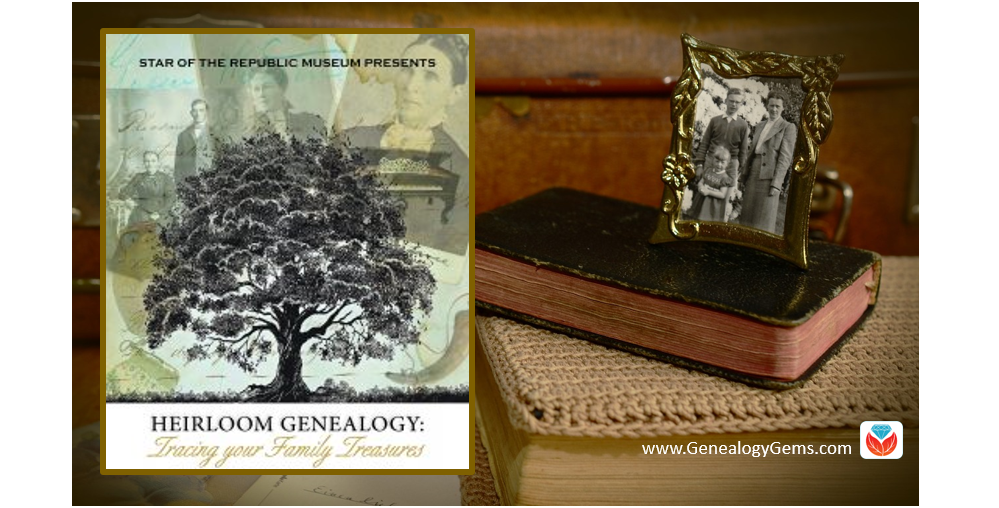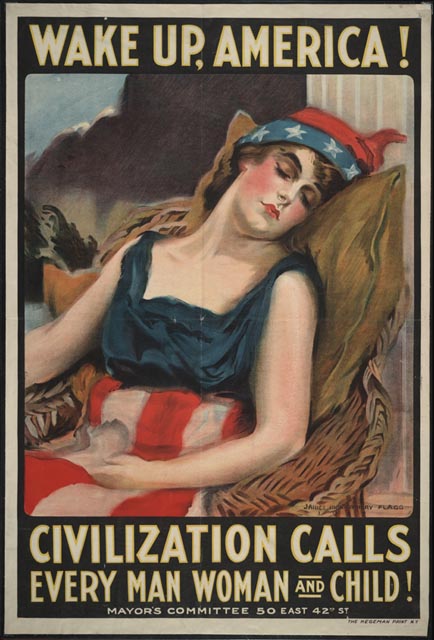TLC Renews “Who Do You Think You Are?” and “Long Lost Family”
 Genealogy is coming back to TV. TLC has renewed “Who Do You Think You Are?” and “Long Lost Family” for additional seasons.
Genealogy is coming back to TV. TLC has renewed “Who Do You Think You Are?” and “Long Lost Family” for additional seasons.
TLC announced on June 9th that the network will have additional seasons of both “Who Do You Think You Are?” and “Long Lost Family.” Both series averaged over 1.8 million viewers.
The two-time Emmy-nominated WDYTYA follows celebrities as they take a personal journey of their family tree. Recent celebrities included Bryan Cranston, who uncovered an ancestor’s heroic dedication during the Civil War, and Molly Ringwald, who learned about the dangerous conditions of her coal-mining ancestors.
The “Long Lost Family” series features the emotional and touching stories of people who have had a separation from their family. The show reunites these individuals and shares their stories of adoption, mystery, and questions. This past season reunited several family members, including a mother and daughter who worked together and did not realize they were related. “Long Lost Family” is hosted by Chris Jacobs and Lisa Joyner, who also share their own stories of adoption.
Ancestry will be teaming up with TLC again as a sponsor for both series. As part of the sponsorship, Ancestry provides the family history research to help make discoveries possible on both series.
Are you a fan of these genealogy-themed shows? We’d love to hear which stories have touched you the most. Please leave a comment below:
The History of Genealogy Gems and of Christmas Seals

Dear Beloved Listeners, Readers, and Viewers,
I’m writing to you today to tell you how much you mean to me. You’re the reason why I can’t wait to grab my phone before I get out of bed, just to see what you’ve had to say. Your emails of shared success stories, challenges, questions, and feedback are each carefully read. Genealogy Gems is after all, created for you.
I so clearly remember the moment back in 2007 when it hit me how creating a podcast would provide me with a way to share what I had learned about researching family history. It would be a way to connect with all of you out there who are in pursuit of the same passion. Now, over 2 million downloads later, we have shared a lot and it’s been glorious.
 Our 10th anniversary together isn’t quite here yet (February 2017), but I do want to dip back into 2007 and share with you one of the first videos I created for you. It was a Christmas story about the origins of Christmas seals, and my own personal story about when I first fell in love with them. I know, the images in the first part of the video are a bit grainy. Online video production was in its infancy way back then in 2007. But, it’s a lovely story just the same, and the Christmas wishes I sent then are still as strong today.
Our 10th anniversary together isn’t quite here yet (February 2017), but I do want to dip back into 2007 and share with you one of the first videos I created for you. It was a Christmas story about the origins of Christmas seals, and my own personal story about when I first fell in love with them. I know, the images in the first part of the video are a bit grainy. Online video production was in its infancy way back then in 2007. But, it’s a lovely story just the same, and the Christmas wishes I sent then are still as strong today.
Have a very Merry Christmas!
Your friend,
Lisa
The Touching Stories our Heirlooms Hold
Some of us are using heirloom research for genealogy. A new exhibit traces the history of interesting heirlooms using genealogical research strategies. Be inspired by these examples and tips to research heirlooms and more fully discover their stories.

A new exhibit called Heirloom Genealogy: Tracing your Family Treasures has opened at The Star of the Republic Museum in Texas. You better believe it caught our interest! We know our readers are looking for unique and different ways to continue their genealogy journeys. We wanted to find out more about how family historians are using heirloom research for genealogy. Curator Shawn Carlson was kind enough to answer some questions about it and share the touching stories the heirlooms held.
Q: What an unusual exhibit idea! How did you think of it?
A: I had been researching artifacts at the museum for several years by tracing the genealogy of the families who donated the artifacts. The best exhibit text usually comes from real stories about artifacts—and doing the genealogy was where I found the stories. When I started thinking about this latest exhibit, I thought maybe there was a way that I could use the genealogical research I already had, and that’s when I came up with the idea of “heirloom genealogy.”
Q: Who was involved in the research and how long did it take?
A: I did all of the research. Some of it had previously been done, but some was new. I usually spend the summer researching for an exhibit, and then write the text and begin production in the fall for a March opening during the Texas Independence Day celebration at Washington-on-the-Brazos.
 Q: Can you share a couple of examples and images of artifacts and the documents that told their stories?
Q: Can you share a couple of examples and images of artifacts and the documents that told their stories?
A: One of the artifacts I researched was a red-on-white appliqué quilt. It was made in 1805 in Vermont and donated by the quiltmaker’s 3X great-granddaughter who lived in Houston. It should have been easy to figure out the lineage by the inscription on the quilt—but it wasn’t. There were two Cynthia Tuckers and two Pearl Browns in the family and one quilt owner had been married a couple of times and used a nickname. So, it took a bit of sorting out. The research was all done using census data, but it all came back to the inscription on the quilt for final verification.

Another item in our collection is a small buckskin suit that belonged to a little boy named Edward Clark Boylan. He was born in New Orleans in 1840 and died three years later near Galveston, probably from yellow fever. We knew his birth and death dates from his sister’s descendant who donated the suit, but not much else. I found some cryptic notes in our files taken by a previous curator and was able to trace Edward to Captain James Boylan who was captain of the ship Brutus during the Texas Revolution.
I found a passenger list from 1839 with Captain Boylan, his wife, and daughter traveling from Puerto Rico to New York. Mrs. Boylan would have been pregnant with Edward during that voyage:

The year that Edward died, his father was mentioned frequently in the newspapers as he led a flotilla of ships out of Campeche. He was probably not present when little Edward died.
Q: What was an especially interesting story you came across while researching this exhibition?
A: One of the most interesting items we’ve received in recent years is a slave birth record that was part of a family collection:

The donor’s ancestors were early settlers of Washington County. The slave record was interesting because it listed birth dates from 1832 to 1865. Out of curiosity, I tried tracking some of the slaves to see if I could find living descendants. I started with the 1870 census—looking for African-Americans with the surname of the plantation owner and first names that matched the slaves in the birth record. I was able to follow through on one of the names to find a living descendant. She and her family came to visit the museum and see the birth record of their ancestor. While the family was visiting during last year’s Texas Independence Day celebration, the donor of the slave record also visited the museum and the two families were able to meet.
Q: What advice do you have for family historians with heirlooms?
A: Learn about the artifacts you have and match them to their owners. There is plenty of information online that will help you identify and date artifacts. Knowing the date of an artifact helps you determine who had it in the past.
More on Heirloom Research for Genealogy
 Connect your heirlooms with their stories and bring the past to life!
Connect your heirlooms with their stories and bring the past to life!
Get Denise Levenick’s popular book How to Archive Family Keepsakes: Learn How to Preserve Family Photos, Memorabilia and Genealogy Records. This book will help you sort, identify, and preserve your own treasured family artifacts and memorabilia.
Disclosure: This article contains affiliate links and Genealogy Gems will be compensated if you make a purchase after clicking on these links (at no additional cost to you). Thank you for supporting Genealogy Gems!
World War I Free Records this Week in New and Updated Records
With the 100th anniversary of America entering World War I, this week we’re shining the spotlight on an immense collection of important WWI records that are available for free at FamilySearch. Here are all the details from their recent press release:
FamilySearch Marks World War I Centennial with Free Historic Record Collections
Salt Lake City, Utah (4 April 2017), Did your ancestor serve in World War I? As the centennial of the United States’ entry into World War I approaches, FamilySearch International is highlighting its free online collections of World War I records. Millions of free draft registration, service, and naturalization records online help fill in details about ancestors who served in the military during the conflict. April 6, 2017, will mark the centennial of the United States’ entry into World War I. Search the free collections at FamilySearch.org.
A century ago, the United States joined its allies to fight in World War I—the “Great War” or the “War to End All Wars.” When the U.S. joined the war effort, battles had already raged in Europe for nearly three years between the Allies and the Central Powers.

Almost five million American military personnel marched to war under the command of General John Pershing, commander-in-chief of the American Expeditionary Force. More than 116,000 Americans died in the war—about half from the Spanish Flu pandemic that swept the globe in 1918, killing millions around the world. Nearly 30,000 American military died of the flu before they even got to France.
The country followed the news of the war, with many people supporting the war effort in industry, farming, and other ways as they waited anxiously for the return of their loved ones. On November 11, 1918, about a year and a half after the United States entered the war, Germany formally surrendered, and terms of peace were negotiated. The nation rejoiced as soldiers returned home to rejoin their families and normal lives. But their experiences helped shape their lives, their posterity, and the country.
As the country remembers that war, many families seek to document the stories of their ancestors and friends who participated in the conflict. The veterans of that conflict are gone now, but many Americans are still alive who listened to the stories told by their parents, grandparents, and great-grandparents of their families’ experience during World War I. Some have documents and old letters, but not everyone has such personalized memorabilia. They may find documents in FamilySearch’s searchable online collections to provide insights.
FamilySearch World War I Records Collections:
- United States World War I Draft Registration Cards, 1917–1918
- California, San Francisco, World War I Enemy Alien Registration Affidavits, 1918
- Louisiana World War I Service Records, 1917–1920
- Maine, World War I Draft Registration Index, 1917–1919
- North Carolina, World War I Service Cards, 1917–1919
- Texas, World War I Records, 1917–1920
- United States Index to Naturalizations of World War I Soldiers, 1918
- United States, YMCA World War I Service Cards, 1917–1919
To find details about an ancestor’s military service, start with the Family History Research Wiki, which directs readers to related documents. Type World War I into the search box in the wiki. The results provide historical context to events during the war, suggestions of records that may provide World War I information, and links to records on other websites.
The most extensive collection on FamilySearch.org is the United States World War I Draft Registration Card collection, with nearly 25 million records. During the course of the war, the amount and kind of information required on draft cards changed, but draft registration cards typically included at least the registrant’s full name, home address, birth date, birthplace, marital status, occupation, physical description, and more.
In addition, many states have registration indexes and card collections that may include other information. For example, searchable state service-card collections on FamilySearch.org for:
provide information about service records, injuries, periods of service, place of birth, age at service or date of birth, units served with, and more for hundreds of thousands of military personnel.
FamilySearch.org has also published searchable images of World War I Enemy Alien Registration Affidavits from San Francisco, California. This collection of records has nearly 34,000 records that offer invaluable genealogical information about noncitizen families during the war, including birth location, countries of citizenship, children, siblings, extended family, educational level, date of arrival in the United States, occupation, languages spoken, a description and a photo of the registrant, and more.
The United States Index to Naturalizations in World War I Soldiers, 1918 offers both indexed information about citizens naturalized during the war and links to images of the actual records.
Census records provide further clues about military service. The 1920 census did not ask questions specific to military service, but the 1930 and 1940 censuses did. Searchable images of the census sheets are online at FamilySearch.org.
One less-known collection containing information about the World War I military comes in records from the Young Men’s Christian Association (YMCA). This volunteer organization provided programs and supplies to support the troops, the sick and wounded, and prisoners of war. Family Search.org has 27,000 images from the YMCA World War I Service Cards, 1917–1919 collection that provide names, addresses, work, religious affiliation, and army service information.
The following World War I books can be found in FamilySearch’s digital book collection online:
- Soldiers of the Great War (3 volumes) lists by state American casualties, killed, wounded, died of disease, etc. Also included are hundreds of individual pictures of soldiers.
- Officers and enlisted men of the United States Navy who lost their lives during the World War from April 6, 1917, to November 11, 1918
- Utah in the World War
- History of the Seventy-Seventh Division, August 25, 1917-November 11, 1918 – The division was made of draftees from New York City
Learn More About World War I for Genealogical Research
Here are three more Genealogy Gems articles to help you discover more about the impact of the Great War on your ancestors:
WWI History App in New and Updated Genealogical Collections
A WWI history app for genealogy leads our top picks for this week! History buffs are going to love Remembering WWI, an app that makes your WWI family history come alive. Also in this week’s new and updated genealogical collections, Swedish church records, Canadian marriage records, Pennsylvania naturalizations, and more.
3 Tips for Finding WWI Ancestors and Their Stories
How did World War I affect your family’s lives? Start your search with these 3 tips for finding WWI ancestors.
Europeana for Genealogy: WWI Digital Archive and More
A major part of Europeana is its World War I digital archive. As the site describes, Europeana “has been running World War I family history roadshows around Europe, helping to digitize people’s stories, documents and memorabilia from 1914-1918.
